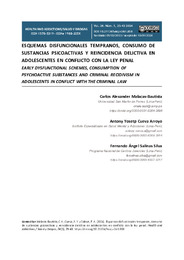Por favor, use este identificador para citar o enlazar este ítem:
https://hdl.handle.net/11000/32037Registro completo de metadatos
| Campo DC | Valor | Lengua/Idioma |
|---|---|---|
| dc.contributor.author | malacas bautista, carlos alexander | - |
| dc.contributor.author | CUEVA ARROYO, ANTONY YOSETP | - |
| dc.contributor.author | salinas silva, fernando angel | - |
| dc.contributor.other | Departamentos de la UMH::Psicología de la Salud | es_ES |
| dc.date.accessioned | 2024-05-03T06:45:27Z | - |
| dc.date.available | 2024-05-03T06:45:27Z | - |
| dc.date.created | 2024-02-22 | - |
| dc.identifier.citation | Health and Addictions Journal/Salud y Drogas Vol. 24 Núm. 1 (2024) | es_ES |
| dc.identifier.issn | 1988-205X | - |
| dc.identifier.issn | 1578-5319 - | - |
| dc.identifier.uri | https://hdl.handle.net/11000/32037 | - |
| dc.description.abstract | Introducción. Esta investigación tuvo por objetivo determinar cuálesson los esquemas disfuncionalestempranos (EDT) que predicen el consumo de sustancias psicoactivas (SPA) y la reincidencia delictiva en adolescentes infractores de los Centros Juveniles (CJ) de Perú. Método. Se empleó un diseño no experimental de tipo transversal y descriptivo; asimismo, se utilizó el Cuestionario de Esquemas de Young- versión reducida (YSQ-SF). La muestra estuvo conformada por 388 adolescentesinfractores de ambos sexos(H=316 y M=72), pertenecientes al CJ-L (260), CJ-A (56) y CJ-SM (72). Resultados. Existe una asociación significativa entre la variable “Consumo de SPA” y 05 EDT, encontrándose que los adolescentes con los EDT de abandono, desconfianza, privación emocional, dependencia y autocontrol insuficiente/impulsividad tienen 2.55, 2.18, 2.46, 3.44 y 1.93, más probabilidades de consumir SPA, respectivamente. Finalmente, se encontró una asociación significativa entre la variable “Reincidencia” y 03 EDT, encontrándose que los adolescentes con los EDT de privación emocional, autocontrol insuficiente y subyugación tienen 1.74, 2.00 y 1.72, más probabilidades de reincidir delictivamente, respectivamente. Conclusiones. Estos resultados sobre la influencia de los EDT en el consumo de SPA y la reincidencia delictiva podrían potenciar el tratamiento de los adolescentes infractores internados en los CJ, dado que guarda mucha relación con uno de los modelos que actualmente mejor explica la adquisición y el mantenimiento de la conducta delictiva a través de tres principios: Riesgo-Necesidad-Respuesta (RNR). | es_ES |
| dc.description.abstract | Introduction. The objective of thisresearch wasto determine which are the early dysfunctionalschemes(EDT) that predict the consumption of psychoactive substances(SPA) and criminal recidivism in adolescent offendersfrom the Youth Centers (CJ) of Peru. Method. A non-experimental cross-sectional and descriptive design was used; likewise, the Young Schema Questionnaire - reduced version (YSQ-SF) was used. The sample consisted of 388 adolescent offenders of both sexes (M=316 and M=72), belonging to the CJ-L (260), CJ-A (56) and CJ-SM (72), the ages of these adolescents’ range between 14 and 22 years old. Results. The results show that a significant association was found between the variable “SPA consumption” and 05 EDT, finding that adolescents with the EDT of abandonment, distrust, emotional deprivation, dependence, and insufficientself-control/impulsivity have 2.55, 2.18, 2.46, 3.44 and 1.93, more likely to consume SPA, respectively. Finally, a significant association was found between the variable “Recidivism” and 03 EDT, finding that adolescents with the EDT of emotional deprivation, insufficient self-control and subjugation have 1.74, 2.00 and 1.72, more likely to reoffend criminally, respectively. Conclusions. These results on the influence of EDTs on SPA consumption and criminal recidivism could enhance the treatment of adolescent offenders admitted to CJs,since it is closely related to one of the modelsthat currently best explainsthe acquisition and maintenance of criminal behavior through three principles: Risk-Need-Response (RNR). | es_ES |
| dc.format | application/pdf | es_ES |
| dc.format.extent | 19 | es_ES |
| dc.language.iso | spa | es_ES |
| dc.publisher | Universidad Miguel Hernández de Elche | es_ES |
| dc.rights | info:eu-repo/semantics/openAccess | es_ES |
| dc.rights | Attribution-NonCommercial-NoDerivatives 4.0 Internacional | * |
| dc.rights.uri | http://creativecommons.org/licenses/by-nc-nd/4.0/ | * |
| dc.subject | Conducta del Adolescente | es_ES |
| dc.subject | Sistema de Justicia | es_ES |
| dc.subject | cognición | es_ES |
| dc.subject | Trastornos Relacionados con Sustancias | es_ES |
| dc.subject | Reincidencia | es_ES |
| dc.subject | Adolescent Behavior | es_ES |
| dc.subject | Justice Administration System | es_ES |
| dc.subject | Cognition | es_ES |
| dc.subject | Substance-Related Disorders | es_ES |
| dc.subject | recidivism | es_ES |
| dc.subject.other | CDU::1 - Filosofía y psicología::159.9 - Psicología | es_ES |
| dc.title | Esquemas disfuncionales tempranos, consumo de sustancias psicoactivas y reincidencia delictiva en adolescentes en conflicto con la ley penal | es_ES |
| dc.title.alternative | Early dysfunctional schemes, consumption of psychoactive substances and criminal recidivism in adolescents in conflict with the criminal law | es_ES |
| dc.type | info:eu-repo/semantics/article | es_ES |
| dc.relation.publisherversion | https://doi.org/10.21134/haaj.v24i1.868 | es_ES |

Ver/Abrir:
868-Texto del artículo anonimizado-5623-4-10-20240222.pdf
526,56 kB
Adobe PDF
Compartir:
 La licencia se describe como: Atribución-NonComercial-NoDerivada 4.0 Internacional.
La licencia se describe como: Atribución-NonComercial-NoDerivada 4.0 Internacional.
.png)